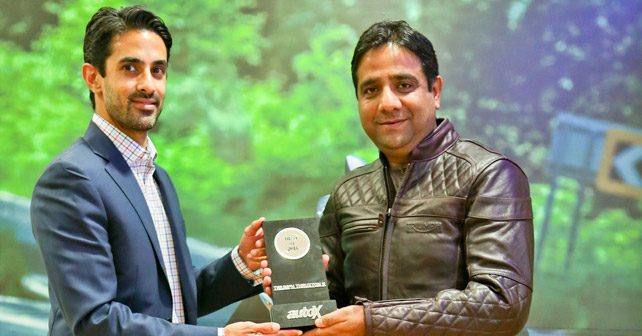
Triumph Thruxton R
Your classics range is all new, how’s it doing so far?
Well, because it’s a new product line up it’s doing extremely well. We’re sold out in fact! The Thruxton R is sold out till Jan-Feb next year, and it’s the same case with the T120. For the T100, we’ve supplied 40 bikes – all of which are booked. But classics are our forte, so I’m not worried on that front. The other area where we’re doing very well is adventure. Our Tiger Academy has done very well for us. If you look at the whole genre of motorcycling, India is strong in the commuter segment. India is also strong in adventure, because we’re very adventurous people. Who would have thought that you could price an adventure bike between 10 and 20 lakhs, and have 525 units on the road.
Do you really think the T100 can become a commuter bike?
Yes, in my opinion, the T100 will become a commuter bike. All over the world, Bonnevilles are ridden to offices. And even in big cities in India, we’re seeing people riding their Bonnies to office. And the manoeuvrability of the T100 is simply phenomenal. It’s such a comfortable motorcycle that I rode it at the Donington Park racetrack for two-and-a-half hours non-stop – it was that comfortable! Plus, it has a 14-litre tank and it’s 22% more fuel efficient than the previous model – so I didn’t even need to stop for fuel. Of course, it’s also lighter than the previous model, so you can literally move the handlebar with your fingertips. Also, the twin-cylinders are phenomenal, because they’re perfectly balanced and work best to reduce vibrations.
What’s your view on GST?
As of now, as I understand it, they haven’t penalized the idea of “luxury” for two-wheelers. But we’ll have to wait to get clarity on that – because it’ll be extremely troublesome if that happens. My opinion is that the Government of India needs to look at premium in a real way, and it needs to look at developing it. If you’re talking about a bullet train in India, then you also have to talk about a Bonneville on Indian roads. Honestly, all of us work very hard to earn a living and sometimes we want to indulge ourselves a little bit. I don’t think someone should be taxed extra because they’ve studied hard and now they work hard. You have to incentivize people to grow. They have to be told that if you work hard you will have a future. Those cases are getting lost at present. That being said, GST will bring in uniform pricing throughout the country. But the states could add a cess, which would nullify the entire benefit. So I’m sure that the government will find a solution to make sure that there’s uniformity in pricing. And, at least as far as the processes go, there will be some uniformity.
How do you see next year unfolding?
India, at the moment, is in a positive frame of mind. We have a stable government, and many of the commitments they made two years ago have started becoming operational now. They’ve brought in a lot of investment, and my assumption is that they’ll start realizing this in the short term. So, the real effect of the new government will come now. For instance, there are a lot of multinational corporations that are entering the county to take up infrastructure projects. Also, in the banking industry, for example, we’re likely to see a new phase emerge in which a lot of the smaller banks that have recently got licenses will start lending and adding liquidity. Moreover, the FDI in retail will open up the network and make it more organized. Lastly, Digital India will help us a lot. But we have to do away with this regime of extra taxation and cess, which is really negative and counterproductive.
On a separate note, for manufacturers like us, the challenges are increasing because the shelf life of every product we bring into the country is getting shorter. India is changing culturally – people have less time on their hands and loyalty patterns are changing. Every six or seven months, people want something new and the expectations are huge. So unless we do something new with our classics every few years, it’ll be difficult. Today, ride-by-wire, traction control, ABS, and Pirelli tyres with different patterns front and rear are new. But people now expect us to create such benchmarks every few years.
So how do you create brand loyalty in that case?
We are completely into experiential marketing. Also we’ve started upgrading people within our portfolio. If you have an old bike you can come and park in our service centres, or we’ll even give you a weekend in our showrooms. If someone wants to buy your bike, it’s a transaction between you and the buyer, but what it does is cement our relationship with our customers. We also provide a two-year, unlimited kilometre warranty, which connects us for a long time with our customers. Also, we’re the only bike company to provide 24x7 roadside assistance pan India. The next thing is that we’re increasing our network, because our customers travel a lot. Plus, of course, we offer better deals to our existing customers in order to promote brand loyalty.
How do you see the premium bike segment progressing in 2017, and beyond?
If you look at premium cars, in 2007, there were roughly 4,000 cars sold through the year – Audi, BMW and Mercedes put together. Last year, they sold about 30,700 cars – so a CAGR of about 38-39%. In 2007, luxury bikes in India – 500cc and up – sold 750-770 units. Last year that went up to 9,000. It’s virtually following big brother, so I expect growth to continue.























Write your Comment